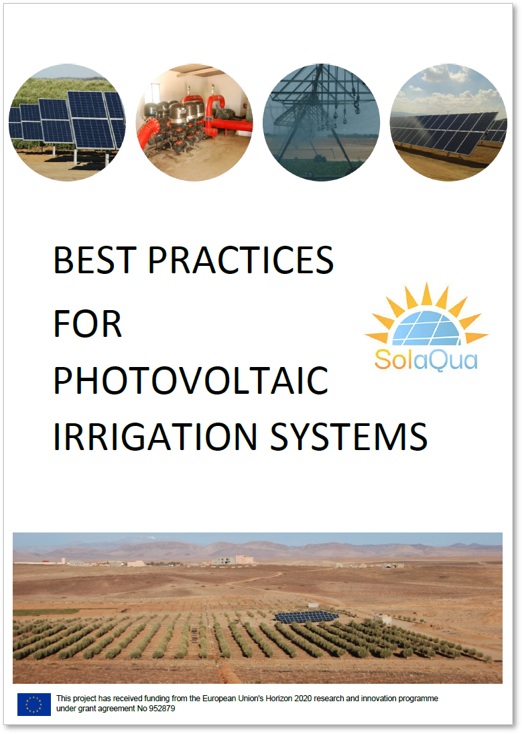Best Practices for Photovoltaic Irrigation Systems (PVIS) is a comprehensive technical manual developed under the Horizon 2020 project SolaQua (Grant Agreement No. 952879). The document compiles best practices, technical specifications, and innovations for planning, installing, operating, and maintaining PV irrigation systems. It addresses the current challenges in agricultural energy use and promotes solar energy as a sustainable solution.
🌱 Project Context & Innovation
SolaQua aims to accelerate the clean energy transition in agriculture by facilitating the market uptake of PVIS in Europe and beyond. The key innovation lies in integrating photovoltaic technology with hydraulic engineering and high-efficiency water management. The project targets over 150,000 farmers, 70 SMEs, and 40 public authorities, focusing on six countries: France, Italy, Spain, Romania, Portugal, and Morocco.
The project developed seven Key Enabling Materials and Tools (KEMTs) to overcome market, technical, and regulatory barriers. This guide represents KEMT 1 and provides a framework to qualify PVIS as bankable and sustainable long-term investments.
🔧 Technology Overview
PVIS systems combine:
-
Photovoltaic (PV) generators for solar energy harvesting.
-
Motor-pumps (centrifugal) for water distribution.
-
Frequency converters (FCs) and Programmable Logic Controllers (PLCs) for smart control.
-
Monitoring systems (including irradiance, temperature, and flow sensors).
-
Supporting structures, ideally North-South horizontal axis trackers for optimized daily water pumping aligned with crop needs.
Innovative configurations include:
-
Stand-alone systems (fully solar-powered without batteries).
-
Hybrid systems using auxiliary energy sources (e.g., grid or diesel).
-
Mixed systems that export energy during non-irrigation periods.
📊 Performance and Optimization
The report introduces critical Key Performance Indicators (KPIs):
-
Performance Ratio (PR): Measures system efficiency including specific PR for PV components (PRPV), irrigation scheduling (UREF), and system design (URPVIS).
-
Passing Cloud Resistance Ratio (σcloud): Evaluates system stability during sudden PV power fluctuations, a key reliability factor.
Control algorithms running on PLCs are highlighted as a technical innovation. These help mitigate abrupt stops caused by rapid irradiance changes, enhancing reliability without battery storage.
🛠️ Design and Implementation Guidelines
Best practices are categorized across four stages:
-
Planning:
-
Prioritize ground installations with adequate sun exposure.
-
Emphasize participatory planning with farmers.
-
Assess water sources (ground vs. surface) and seasonal availability.
-
Consider regulatory and land-use restrictions.
-
-
Designing:
-
Use the UPM-developed SISIFO software for simulation and sizing.
-
Match PV output to irrigation requirements during peak months.
-
Incorporate appropriate sensor and monitoring setups.
-
-
Installing:
-
Conduct quality checks before deployment (e.g., PV module tests, motor-pump calibration).
-
Implement standardized installation steps for FCs, wiring, drainage, and security.
-
-
Operating & Maintaining:
-
Establish preventive, corrective, and predictive maintenance plans.
-
Ensure availability of spare parts.
-
Evaluate system performance at least biannually.
-
🔗 Technology-Application Links (Highlighted)
-
North-South Axis Trackers ⟶ Improve alignment between solar generation and irrigation demand; require less PV peak power to pump the same water volume (Figure 9, ~1.75x less vs. static structures).
-
Hybrid systems ⟶ Ensure continuity in irrigation during peak demand or low irradiance months; performance monitored using PV share index (PVS).
-
Passing Cloud Algorithms ⟶ Avoid FC abrupt stops without batteries; based on real-time irradiance drop detection.
💡 Policy and Market Impact
SolaQua fosters new business models, introduces a new EAFRD financial instrument in 3 EU regions, and supports more than 100 MW of PVIS deployment, potentially reducing costs and increasing sustainability of irrigation in agriculture.

